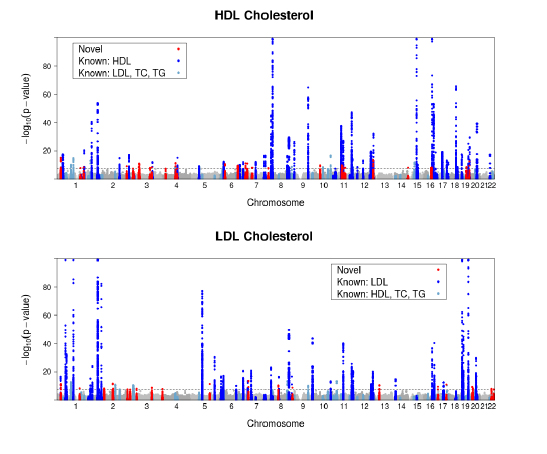Big data getting to the heart of disease

These genetic regions imply that there is an array of genes that underlie diseases such as coronary artery disease, type 2 diabetes, obesity and high blood pressure, linked to increased lipid levels. These genes could help to find treatments against these diseases.
Coronary artery disease is one of the biggest killers in western society, with an estimated 7 million deaths each year. Increased blood lipid levels are a major risk factor for coronary artery disease. This study identifies potential new targets for therapy for cholesterol management and the prevention of heart disease.
“We have found many new components of the biological pathways marking blood lipid levels an important risk factor for coronary artery disease. Our study found a causal role for LDL-cholesterol and triglycerides in heart disease but not for HDL-cholesterol,” says Professor Panos Deloukas, a senior author from the Wellcome Trust Sanger Institute and William Harvey Research Institute, Queen Mary University London. “This research could open doors in the future to new treatment options for those most at risk.”
The study was huge; the Global Lipids Genetics Consortium — a worldwide team of scientists looked at variation and clinical information in close to 190,000 people from across the world and identified 152 genetic regions associated with lipid levels, including 62 newly associated genetic regions.
They found 240 genes close to these regions that could be implicated in disease. From this 240, they prioritised a further 70 genes that, based on several criteria, they will study in greater detail to pin down the culprits.
Previous studies in mice showed that switching off the gene Gpr146 modifies blood lipid levels. In this study, the team found that variants near human GPR146 are associated with altered levels of cholesterol in the blood. GPR146 is an attractive pharmaceutical target as it controls a protein, known as G-coupled protein receptor that sends messages to the cells. This study provides additional incentive for studies of GPR146 inhibitors to modify cholesterol levels and reduce the risk of heart disease.
“It will take much further work to study the implicated genes and to find and test potential drugs that could target them,” says Professor Gonçalo Abecasis, senior author from the University of Michigan, School of Public Health. “The consortium’s ‘open science’ approach will include publishing further detail online for other researchers to use freely toward this goal.”
This study highlights the power of large science and how using samples from a range of people can empower the search for disease-causing variants. This research would not have been possible without the power of a large consortium; bringing together large numbers of DNA samples and sharing expertise between the many groups.
Collectively, these findings have begun to illuminate the biological mechanisms behind coronary artery disease and other diseases. This study provides a useful tool for future projects to elucidate the biological processes underlying these diseases and to investigate how genes work together to cause disease.
More information
In a companion study, researchers found that triglycerides have a larger impact on risk of coronary artery disease that was previously thought. They examined 185 DNA variants across the genome, showing that genetically-elevated triglycerides are associated with increased risk for coronary artery disease, even after accounting for effects on plasma LDL cholesterol and HDL cholesterol.
Funding
A full list of funding can be found on the paper.
Participating Centres
A full list of participating centres can be found on the paper.
Publications:
Selected websites
The Wellcome Trust Sanger Institute
The Wellcome Trust Sanger Institute is one of the world’s leading genome centres. Through its ability to conduct research at scale, it is able to engage in bold and long-term exploratory projects that are designed to influence and empower medical science globally. Institute research findings, generated through its own research programmes and through its leading role in international consortia, are being used to develop new diagnostics and treatments for human disease.
The Wellcome Trust
The Wellcome Trust is a global charitable foundation dedicated to achieving extraordinary improvements in human and animal health. We support the brightest minds in biomedical research and the medical humanities. Our breadth of support includes public engagement, education and the application of research to improve health. We are independent of both political and commercial interests.


